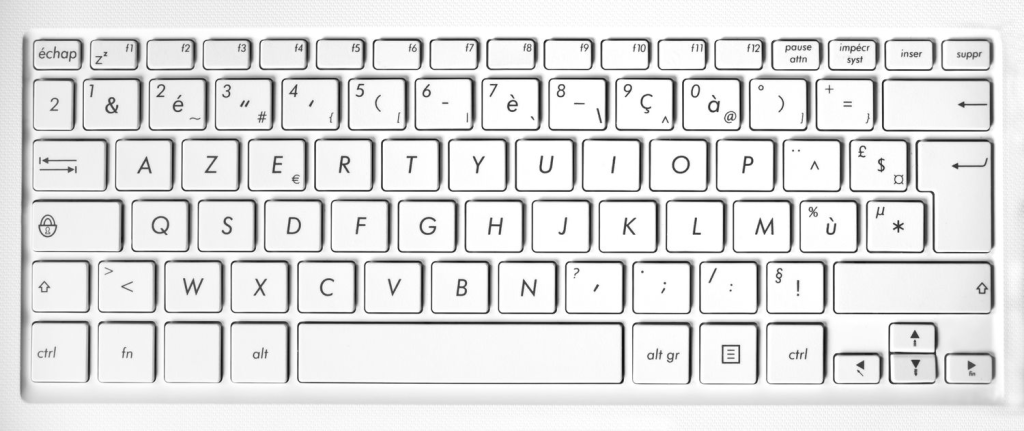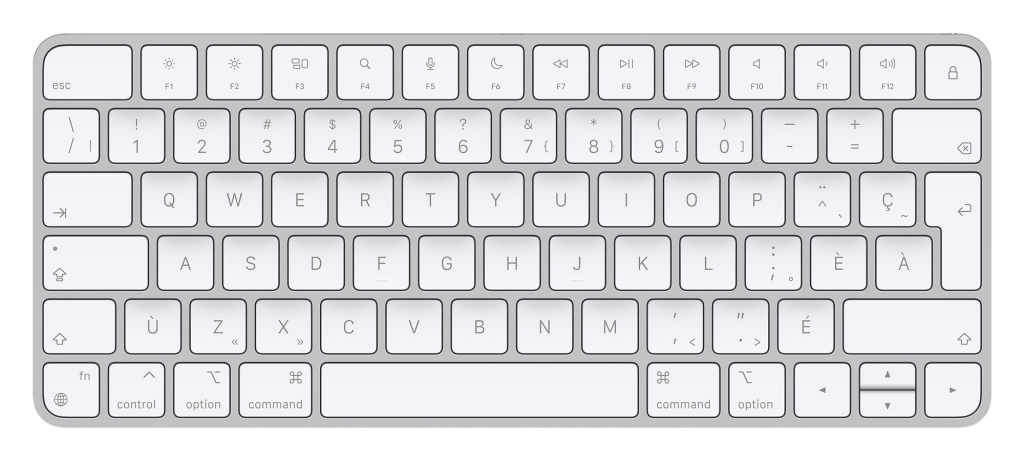In this comprehensive blog post, I am going to explain How to Type French Accents, Easy Accent Codes and Shortcuts.
You don’t have to purchase a special French keyboard or software to add French accents. You can type them using different methods on Windows, Apple, and Linux computers.
Check also: French Verb Devoir Conjugation, Meaning, Translation, Examples
Typing French Accents in Windows
You have various choices depending on your computer and keyboard:
- If you’re using the English-US keyboard layout, the international keyboard setting is the most convenient option for typing accents. It’s not a different physical keyboard; it’s just a Windows setting.
- For English-UK keyboard users, the UK extended keyboard is the recommended choice.
- Alternatively, you can also use the French keyboard, the Canadian French keyboard, or ALT codes as other options for typing accents.
Typing French Accents on an Apple
When typing French accents on an Apple computer, you have a few options based on your operating system (OS):
- Option key accents.
- KeyCaps.
- Special character palette.
- Setting the language of your OS to French.
Windows: International Keyboard
For U.S. English keyboard users on Windows, the international keyboard, which is a Control Panel setting and not a physical keyboard, is the simplest way to type French accents. It keeps the familiar QWERTY layout with a few changes and additions:
- To type an accent grave (à, è, etc.), press the ` key (to the left of 1) and then the vowel.
- For an accent aigu (é), press the single quote key ‘ and then e.
- To type a cédille (ç), press ‘ and then c.
- To add a circonflexe (ê), press the ^ key (shift + 6) and then e.
- For a tréma (ö), press the double quote key ” (shift + ‘) and then o.
- To type French quotation marks « » use ctrl + alt + [ and ], respectively.
Note: The only minor drawback of using the international keyboard is that when you want to type characters like single or double quotes without adding them above a vowel, you have to type the symbol and then press the spacebar. For instance, to type “c’est,” you should type “c,” then “‘”, then hit the spacebar, and finally type “e,” “s,” and “t.” It may take a bit of practice to remember that extra space when you just want to type ‘ or “.
If you encounter issues like getting “cést” when you intend to type “c’est,” please review the note above.
To use the international keyboard for typing French accents, you’ll need to select that specific keyboard layout in your computer’s settings.
Windows: UK Extended
If you’re using a UK keyboard, the UK extended keyboard is likely the most convenient way to type French accents while keeping your keyboard layout. You can access most accents using the AltGr key, located to the right of the spacebar. Here’s how to type French accents with this method:
- For accent grave (à, è, etc.), press ` (to the left of 1) and then the vowel.
- To type accent aigu (é), simultaneously press AltGr and e.
- For the cédille (ç), simultaneously press AltGr and c.
- To add a circonflexe (ê), simultaneously press AltGr and ^, and then the vowel.
- To type tréma (ö), simultaneously press AltGr and “, and then the vowel.
To use the UK extended keyboard to type French accents, you’ll need to select this specific keyboard layout in your computer’s settings.
Windows: French keyboard

The French keyboard, known as AZERTY, has a layout that differs somewhat from other keyboard layouts like QWERTY. If you’re accustomed to QWERTY, it’s advisable to use the international keyboard.
With the French keyboard layout, you’ll notice several changes, including the swapping of A and Q, W and Z, and the shift requirement for numbers. On the flip side, you can easily type the grave accent (à, è, ù) and acute accent (é) with a single key, and other accented letters using a combination of two keys:
- To type anything with a circumflex (â, ê, etc.), press ^ and then the vowel.
- For a tréma (ä, ë, etc.), press ¨ and then the vowel.
To use the French keyboard for typing French accents, you should select the appropriate keyboard layout in your computer’s settings.
Canadian French Keyboard

The layout of the Canadian French keyboard is similar to QWERTY, which can be simpler if that’s what you’re accustomed to (although the international keyboard is still a better option in my opinion). Typing accents on the Canadian French keyboard is straightforward:
- To type an acute accent (é), press ´ (located next to the right-hand shift key), and then e.
- For a grave accent (à, è, ù), type ‘ (apostrophe / single quote), and then the vowel.
- The circumflex ˆ and tréma ¨ are placed in the upper-right corner, side by side next to the enter key.
- To type ç, press ¸ (located to the left of “enter”), and then c.
To use the Canadian French keyboard to type French accents, you’ll need to select that specific keyboard layout in your computer’s settings.
Windows: Selecting a Keyboard Layout
To use one of these alternate keyboard layouts, you need to add it to your Windows settings. After adding it, you can make it your default keyboard or toggle between multiple layouts using Alt + Shift. The method for doing this varies slightly depending on your operating system.
Windows 11
In Windows 11, you can add an alternate keyboard layout by following these steps:
- Click on the “Start” button in the lower-left corner of your screen.
- Select “Settings” (the gear-shaped icon) to open Windows Settings.
- In Windows Settings, click on “Time & Language.”
- Choose “Language” from the options on the left.
- Under “Preferred languages,” click on your language.
- Click on “Options” next to your language.
- Under the “Keyboards” section, click “Add a keyboard.”
- Scroll down to the language you want to add, click on it to expand the options, and then select the keyboard layout you prefer.
- Click “Add” to add the new keyboard layout.
- You can now switch between keyboard layouts by pressing the Windows key + Spacebar or by clicking the language/keyboard icon in the taskbar and selecting the layout you want to use.
Windows 10
For Windows 10, you can add an alternate keyboard layout by following these steps:
- Click on the “Start” button in the lower-left corner of your screen.
- Go to “Settings” (the gear-shaped icon) to open the Windows Settings.
- In the Windows Settings, select “Time & Language.”
- Choose “Language” from the options on the left.
- Under “Preferred languages,” click on your language.
- Click on “Options” next to your language.
- Under the “Keyboards” section, click “Add a keyboard.”
- Scroll down to the language you want to add, click on it to expand the options, and then select the keyboard layout you prefer.
- Click “Add” to add the new keyboard layout.
- You can now switch between keyboard layouts by pressing the Windows key + Spacebar or by clicking the language/keyboard icon in the taskbar and selecting the layout you want to use.
Windows 8
On Windows 8, you can add an alternate keyboard layout by following these steps:
- Open Control Panel.
- Under “Clock, Language, and Region,” click “Change input methods.”
- Click “Options” to the right of your language.
- Click “Add an input method.”
- Scroll down to the language you want to add, click the “+” symbol next to it, and then select the layout you prefer.
- Click OK in each dialog window to save your changes.
Windows 7
In Windows 7, you can add an alternate keyboard layout by following these steps:
- Open Control Panel.
- Under “Clock, Language, and Region,” click “Change keyboards or other input methods.”
- Click “Change keyboards.”
- Click “Add.”
- Scroll down to the language you want to add, click the “+” symbol next to it, and then select the keyboard layout you prefer.
- Click “OK” in each dialog window.
- To use the layout, click the language input button on the taskbar (it likely says “EN” for English), and select the layout you’ve added.
Windows Vista
For Windows Vista, you can add an alternate keyboard layout by following these steps:
- Open Control Panel.
- If you are in Classic View, click “Control Panel Home” in the upper-left corner.
- Under “Clock, Language, and Region,” click “Change keyboards or other input methods.”
- Click “Change keyboards.”
- Click “Add.”
- Scroll down to the language you want to add, click the “+” symbol next to it, and then select the keyboard layout you prefer.
- Click “OK” in each dialog window to save your changes.
Windows XP
For Windows XP, you can add an alternate keyboard layout by following these steps:
- Open Control Panel.
- Double-click “Regional and Language Options.”
- Click the “Languages” tab.
- Click the “Details” button.
- Click “Add.”
- Under “Input Language,” select the language you want to add.
- Under “Keyboard layout/IME,” choose the keyboard layout you prefer.
- Click “OK” in each dialog window to save your changes.
Windows 95, 98, ME, NT
For older Windows operating systems like Windows 95, 98, ME, and NT, you can add an alternate keyboard layout by following these steps:
- Open Control Panel.
- Double-click “Keyboard.”
- Click the “Language” tab.
- Click “Properties,” “Settings,” or “Details” (the specific wording may vary based on your Windows version).
- Click “Add.”
- Pick the layout you want to add.
- Click “OK” in each dialog window to save your changes.
Windows 2000
For Windows 2000, you can add an alternate keyboard layout by following these steps:
- Open Control Panel (you can access it through the Start menu or My Computer).
- Double-click “Keyboard.”
- Click the “Input Locales” tab.
- Click “Change.”
- Click “Add.”
- Select the layout you want to add.
- Click “OK” in each dialog window to save your changes.
Layout names
- International Keyboard: English (United States), US-Int’l
- UK Extended Keyboard: English (UK – extended)
- French Keyboard: French (Standard)
- French Canadian Keyboard: French (Canadian)
Windows: ALT codes
Typing accents on a PC using ALT codes is possible but less convenient than the international keyboard. ALT codes require using the ALT key and a 3 or 4-digit code. However, it’s important to note that ALT codes only function with the numeric keypad, not the row of numbers along the top of your keyboard. They won’t work on a laptop unless you enable number lock to activate the number pad located on the right side of your keyboard. This can be cumbersome because it affects the functionality of the letter keys. In summary, for laptop users, it’s easier to opt for a different keyboard method rather than dealing with ALT codes.
To type accents with ALT codes, press and hold the ALT key, then enter the three or four digits for the specific character. When you release the ALT key, the accented character will appear.
To type various French accented characters and symbols using ALT codes, you can use the following combinations:
- à: ALT + 133, À: ALT + 0192
- â: ALT + 131, Â: ALT + 0194
- ä: ALT + 132, Ä: ALT + 142
- æ: ALT + 145, Æ: ALT + 146
- ç: ALT + 135, Ç: ALT + 128
- é: ALT + 130, É: ALT + 144
- è: ALT + 138, È: ALT + 0200
- ê: ALT + 136, Ê: ALT + 0202
- ë: ALT + 137, Ë: ALT + 0203
- î: ALT + 140, Î: ALT + 0206
- ï: ALT + 139, Ï: ALT + 0207
- ô: ALT + 147, Ô: ALT + 0212
- œ: ALT + 0156, Œ: ALT + 0140
- ù: ALT + 151, Ù: ALT + 0217
- û: ALT + 150, Û: ALT + 0219
- ü: ALT + 129, Ü: ALT + 154
- «: ALT + 174, »: ALT + 175
- €: ALT + 0128
Remember to press and hold the ALT key while typing the corresponding numeric code, and then release the ALT key to display the accented character or symbol.
Apple: Option Key and KeyCaps
To type accents on an Apple using the option key, follow these instructions. Hold down the option key while pressing the key(s) in bold from this list. For instance, to type ê, hold the option key while pressing i, then release both keys and press e. To type î, hold the option key, press i, release both keys, and then press i again.
Please note that “and” means to keep holding the option key and the first key listed while typing the second, while “then” means to release the option key and the first key before typing the second.
- acute accent é: Hold the option key and press e, then press e again.
- grave accent à, è, ù: Hold the option key and press `, then press a, e, or u.
- cedilla ç: Hold the option key and press c.
- circumflex â, ê, î, ô, û: Hold the option key and press i, then press a, e, i, o, or u.
- tréma ë, ï, ü: Hold the option key and press u, then press e, i, or u.
- oe ligature œ: Hold the option key and press q.
Remember, when “and” is mentioned, it means to keep holding the option key and the first key listed while typing the second. When “then” is mentioned, it means to release the option key and the first key before typing the second.
Apple: Option Key and KeyCaps
To type the previously mentioned accents as capital letters, add the shift key to the first step. For example, to type É, hold the shift key, option key, and e, and then press e again.
For the other characters:
- French quotation marks «: Hold the option key and press .
- French quotation marks »: Hold the option key and shift key, and press .
- Euro symbol €: Hold the option key and shift key, and press 2.
For Mac users with OS9 and below, KeyCaps is a helpful tool. Here’s how to use it:
- Click on the Apple menu in the top left corner of the screen.
- Open KeyCaps (a little keyboard will appear on the desktop).
- Hold down the option key, and the accents will appear. You can click on them with the mouse.
For example, to type ù, hold the option key, click `, and then type u. The accented character will appear.
Apple: Special Character Palette
To open the special character palette and type accents on a Mac, follow these steps:
- Click “Edit” in the menubar at the top of your screen.
- Click “Special Characters.”
- Select “Roman” from the View pulldown menu.
- Choose the “Accented Latin” character palette.
- Keep the palette open for use in any application.
To use the palette:
- Place your cursor at the point in the document where you want to insert an accented character.
- Click on the desired accented character in the palette.
- Click “Insert” at the bottom of the palette to add the character to your document.
Apple: French OS
To type French accents and immerse yourself in French on an Apple macOS by setting your system language to French, follow these steps:
- Go to “System Preferences.”
- Choose “International.”
- Change the system operating language to French.
This will configure your macOS and most Apple software to use the French language, making it easier to type French accents and engage with the language.
Linux
In Linux, you have two methods to type accents:
- Character Palette (Ubuntu 10.04):
- Right-click on the top bar and select “Add to Panel.”
- Choose and add “Character Palette.”
- The small arrow on the left will provide a choice of palettes, which you can customize to include the necessary accented characters.
- Left-click on a character, and then hold down the Control key and type V to insert it at the cursor position.
- Compose Key:
- Specify an unused key (e.g., the Windows key) to be the Compose Key. This key will allow you to create accented characters easily.
- For example, you can hold down the Compose Key and type e` to get è or o” to get ö. The combinations are quite intuitive.
- The location for specifying the Compose Key might vary depending on your Linux distribution. On a SuSE installation, you can go to Control Center > Accessibility Options > Keyboard Properties > Options > Compose Key option to configure it.
Android
If you have an Android tablet or smartphone, you can use the Smart Keyboard app to access accented letters. Here’s how to set it up:
- Download the trial version or pro version of the Smart Keyboard app and install it on your device.
- Go to “Language and keyboard” in your device’s settings and check the “Smart Keyboard” box.
- Navigate to “Settings” > “Language” > “Current Language” and choose “English (International).”
- Open any app with a text box and tap inside it to activate a popup menu. Choose “Input Method” and then select “Smart Keyboard.”
You’re now ready to type accented letters:
- To type à, press and hold the letter a, then choose à.
- To type é, è, ê, or ë, press and hold e, then make your selection.
- For ç, press and hold the letter c.
The app will provide a list of accented letters for you to choose from, making it easier to type French accents on your Android device.
iPhone and iPad
To type accented letters on an iPhone or iPad, follow these steps:
- Press and hold the button for the unaccented letter you want to type for a moment.
- A list of accented letters will pop up for you to choose from.
For example:
- To type à, press and hold the letter a, then choose à.
- To type é, è, ê, or ë, press and hold e, then make your selection.
- For ç, press and hold the letter c.
This method allows you to easily access and use accented letters on your iPhone or iPad when typing in French or other languages that require diacritics.
Conclusion
typing French accents doesn’t have to be a daunting task. With a variety of easy-to-use accent codes and shortcuts available on different devices and platforms, you can effortlessly add accented characters to your text, enhancing your ability to communicate in the French language or other languages that use diacritics. Whether you’re on a computer, smartphone, or tablet, these methods make typing accents a straightforward and accessible process.
If you really enjoyed the article about “How to Type French Accents,” then I would be very grateful if you’d help it spread by emailing it to your friends or sharing it on Twitter, Instagram, or Facebook. Thank you!
Have you read “How to Type French Accents?“ Which of these blogs are you reading, and how is it similar to one of them?
Read More
- Mastering French Demonstrative Adjectives (Adjectifs Démonstratifs)
- Mastering French Demonstrative Pronouns (Pronoms démonstratifs)
- French Verb Envoyer Conjugation, Meaning, Translation, Examples
- French Verb Asseoir Conjugation, Meaning, Translation, Examples
- French Verb Aimer Conjugation, Meaning, Translation, Examples







